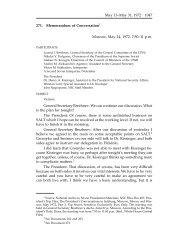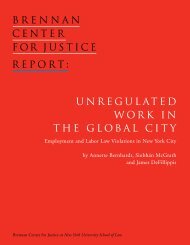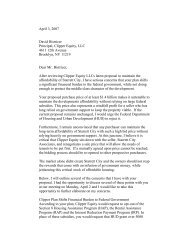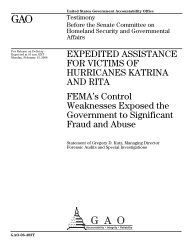Strengthening Schools by Strengthening Families
Strengthening Schools by Strengthening Families
Strengthening Schools by Strengthening Families
You also want an ePaper? Increase the reach of your titles
YUMPU automatically turns print PDFs into web optimized ePapers that Google loves.
In cases where parents are more willing to be involved, Bridge Builders can be more forgiving. For<br />
example, Bear recalled the case of a young boy who came to school with a mark on his face. When<br />
confronted about it, he said that his mother had hit him with a belt. But when Bear visited the home,<br />
which doubled as a day care, she found his mother attentive and apologetic. The mother, then seven<br />
months pregnant, said she was feeling overwhelmed and it was a one-time mistake. Bear took her at<br />
her word. “It’s kind of like the quintessential Bridge Builders case,” she says. “When something is of<br />
great concern to the school, but it’s an isolated incident, let’s see if this works, let’s see what we can<br />
do.” Still, she monitored the case closely, and made sure the mother had support services. “It will be<br />
really telling how motivated she is, how receptive to interventions,” she says.<br />
The relationship between Bridge Builders and its schools varies widely, and much depends on local school<br />
leadership. The program has gotten a warm reception at P.S. 11 and P.S. 126. But at P.S. 73, it was barely<br />
tolerated until a new principal arrived in 2007. Before that, the program was not given permanent office<br />
space, Bear says, nor was it adequately explained to the students or staff. Bear recounted one instance at<br />
P.S. 73 when a teacher asked her to ba<strong>by</strong>sit an unruly student. “You deal with bad kids, right?” the teacher<br />
had said within earshot of the student, insensitive to how a comment like that could stigmatize the<br />
child—and the program. Eventually, the principal there pulled the plug on Bridge Builders, instructing<br />
the parent coordinator to tell them to leave the school without even saying good<strong>by</strong>e to their students.<br />
By contrast, the school’s new principal, Jean Mirvil, has been supportive, inviting Bridge Builder<br />
staffers to speak at back-to-school events and PTA meetings. “That way, the communication was clear<br />
and nobody was scared of anybody,” Mirvil says. “We know we are all there to provide the kind of<br />
support that youngsters are in need of.”<br />
Even in the first difficult year that it operated at P.S. 73, Bridge Builders managed to make some<br />
inroads. “It’s like a support system—especially for parents, for the school, for the student and for<br />
the administration,” says Assistant Principal Arcania Jaquez, who worked in P.S. 11, another Bridge<br />
Builders school, before coming to P.S. 73. She says that family problems are too often passed from<br />
one teacher to the next until they erupt and ACS has to be called. Bridge Builders provides a way to<br />
intervene before things reach that point, she says. “When your tooth hurts you, you go to the dentist,”<br />
she says. “When your child has problems impeding their education, you should deal with it.”<br />
On the financial side, Bridge Builders’ school program is far less expensive than some of the other<br />
school-based models. In 2006, the program cost $125,100 for all three schools combined. By 2008,<br />
the budget had decreased to $97,000, as foundation grant commitments came to an end. Instead of<br />
two full-time staffers, the school program had just one full-time and one-part time staffer. The schools<br />
refer about 100 families a year.<br />
CAsE sTUDY: Kidwise<br />
Olu Atanda-Ogunleye, a social worker based at a middle school in southeast Queens, remembers<br />
when he could help kids and parents with their social and emotional problems and not make<br />
a big deal out of it. Students could stop <strong>by</strong> his office for a chat, or he could stop <strong>by</strong> the lunchroom<br />
to see how they were doing. He could talk informally to parents, take children on what he called<br />
“therapeutic” field trips to places like the American Museum of Natural History, and even buy needy<br />
students clothes or groceries. He organized support groups for parents, gave Thanksgiving dinners to<br />
kids, mediated disputes between teachers and students, and even planned trips to colleges.<br />
Now all that has changed, says Atanda-Ogunleye, project director for Kidwise, a mental health clinic<br />
housed in M.S. 72 and run <strong>by</strong> Safe Space, a nonprofit organization. Not only has his budget been<br />
slashed from $367,000 in 2007–2008 to $220,000 in 2008–2009, but new regulations promulgated<br />
The relationship<br />
between Bridge<br />
Builders and its<br />
schools varies<br />
widely, and<br />
much depends<br />
on local school<br />
leadership.<br />
33

















